
FACULTY OF ARTS AND SCIENCES
Department of English Translation and Interpreting
ETI 217 | Course Introduction and Application Information
| Course Name |
Computer Assisted Translation Studies
|
|
Code
|
Semester
|
Theory
(hour/week) |
Application/Lab
(hour/week) |
Local Credits
|
ECTS
|
|
ETI 217
|
Fall
|
3
|
0
|
3
|
6
|
| Prerequisites |
None
|
|||||
| Course Language |
English
|
|||||
| Course Type |
Required
|
|||||
| Course Level |
First Cycle
|
|||||
| Mode of Delivery | face to face | |||||
| Teaching Methods and Techniques of the Course | DiscussionQ&ACritical feedbackSimulationLecture / Presentation | |||||
| Course Coordinator | ||||||
| Course Lecturer(s) | ||||||
| Assistant(s) | - | |||||
| Course Objectives | This course aims to develop the students' skills of computer use and to make them efficient in using this technology in translation studies. |
| Learning Outcomes |
The students who succeeded in this course;
|
| Course Description | This course focuses on topics that are of importance for the translation industry such as translation tools, translation memory systems, interpreting technologies, use of search engines and corpora in translation, machine translation, Microsoft Office applications and Google tools. |
|
|
Core Courses | |
| Major Area Courses |
X
|
|
| Supportive Courses | ||
| Media and Management Skills Courses | ||
| Transferable Skill Courses |
WEEKLY SUBJECTS AND RELATED PREPARATION STUDIES
| Week | Subjects | Related Preparation |
| 1 | Introduction: Technology and Translation | Lynne Bowker, “Why Do Translators Need to Learn about Technology”, chap. 1 in Computer-aided translation technology: a practical introduction, (Ottawa: University of Ottawa Press, 2002), 11-22. ISBN-13: 978-0776605388. Frank Austermuhl, “Translation in the information age” chap. 1 in Electronic tools for translators (S.L.: Routledge, 2016), 1-17. ISBN: 9781315760353. |
| 2 | Operating Systems. Translation Tools and Workflow. Advanced features of MS Word | European Union Directorate-General for Translation Publications. ISBN 978-92-79-08849-0. |
| 3 | Search Engines. The Impact of Internet on Translation. Effective communication through technology. | Frank Austermuhl, “Translator–client communication and information transfer”, “Translation and the Internet”, “Searching the web” chap. 2-3-4 in Electronic tools for translators (S.L.: Routledge, 2016), 18-52. ISBN: 9781315760353. |
| 4 | Capturing Data in Electronic Form. Desktop Publishing | Lynne Bowker, “Capturing Data in Electronic Form”, chap. 2 in Computer-aided translation technology: a practical introduction (Ottawa: University of Ottawa Press, 2002), 22-42. ISBN-13: 978-0776605388. |
| 5 | Microsoft Office Applications. Google Tools (Powerpoint, Google Drive etc.) | Ryan Teeter & Karl Barksdale, "Getting to Work: Documents, Spreadsheets, and Presentations ", chap 3. in Google Apps for Dummies, (USA: John Wiley & Sons, Incorporated, 2008), 155-254 ISBN: 9780470189580. |
| 6 | Translation Management Systems | Selected texts |
| 7 | Midterm | |
| 8 | Translator's Workstation. | Harold Somers, "The translator’s workstation" chap. 2 in Computers and translation: a translator's guide (Amsterdam: John Benjamins Publishing Company, 2003). ISBN 9789027296696. |
| 9 | Translation Memory Systems. Terminology Management Systems, Trados | Harold Somers, "Translation memory systems" chap. 3 in Computers and translation: a translator's guide, (Amsterdam: John Benjamins Publishing Company, 2003). ISBN 9789027296696. |
| 10 | Translation Memory Systems. Terminology Management Systems. (Cloud softwares, Smartcat etc.) | Lynne Bowker, "Terminology tools for translators" chap. 4 in Computers and translation: a translator's guide, (Amsterdam: John Benjamins Publishing Company, 2003). ISBN 9789027296696. |
| 11 | Quiz | |
| 12 | Machine Translation. Localization | Bert Esselink, "Localisation and translation" chap. 5 in Computers and translation: a translator's guide, (Amsterdam: John Benjamins Publishing Company, 2003). ISBN 9789027296696. |
| 13 | Web 2.0 for Translators. Corpora and translation. (Proz, Translatorscafe, Gala, Elia etc) | Sara Laviosa, "Corpora and the translator", chap. 7 in Computers and translation: a translator's guide, (Amsterdam: John Benjamins Publishing Company, 2003). ISBN 9789027296696. |
| 14 | Sound, Video, Image Editing. Interpreting technologies. | Mehmet Şahin, "Yazılım, Donanım ve Araçlar", chap. 3 in Çeviri ve Teknoloji, (İzmir: İzmir Ekonomi Üniversitesi, 2013). ISBN: 978-9758789-52-8. |
| 15 | Semester Review | |
| 16 | Final exam |
| Course Notes/Textbooks | Lynne Bowker, “Computer-aided translation technology: a practical introduction”, (Ottawa: University of Ottawa Press, 2002). ISBN-13: 978-0776605388. Frank Austermuhl, “Electronic tools for translators”, (S.L.: Routledge, 2016). ISBN: 9781315760353. Harold Somers, "Computers and translation: a translator's guide", (Amsterdam: John Benjamins Publishing Company, 2003). ISBN 9789027296696. |
| Suggested Readings/Materials | Ryan Teeter & Karl Barksdale, “Google Apps for Dummies”, (USA: John Wiley & Sons, Incorporated, 2008). ISBN: 9780470189580. Harold Somers, “Computers and translation: a translator's guide”, (Amsterdam: John Benjamins Publishing Company, 2003). ISBN 9789027296696. Daniel Gouadec, “Translation as a profession”, (Amsterdam: John Benjamins Publishing Company, 2007). ISBN 9789027292513. Minako O'Hagan and David Ashworth, “Translation- mediated Communication in a Digital World: Facing the Challenges of Globalization and Localization”, (Clevedon: Multilingual Matters, 2002). ISBN: 9781853595820. Mehmet Şahin, “Çeviri ve Teknoloji”, (İzmir: İzmir Ekonomi Üniversitesi, 2013). ISBN: 978-9758789-52-8. Directorate-General for Translation (European Commission), “Translation at the European Commission - A history”, (European Communities, 2010). ISBN 978-92-79-08849-0. |
EVALUATION SYSTEM
| Semester Activities | Number | Weigthing |
| Participation |
1
|
10
|
| Laboratory / Application | ||
| Field Work | ||
| Quizzes / Studio Critiques |
1
|
10
|
| Portfolio | ||
| Homework / Assignments |
1
|
10
|
| Presentation / Jury | ||
| Project | ||
| Seminar / Workshop | ||
| Oral Exams | ||
| Midterm |
1
|
20
|
| Final Exam |
1
|
50
|
| Total |
| Weighting of Semester Activities on the Final Grade |
4
|
50
|
| Weighting of End-of-Semester Activities on the Final Grade |
1
|
50
|
| Total |
ECTS / WORKLOAD TABLE
| Semester Activities | Number | Duration (Hours) | Workload |
|---|---|---|---|
| Theoretical Course Hours (Including exam week: 16 x total hours) |
16
|
3
|
48
|
| Laboratory / Application Hours (Including exam week: '.16.' x total hours) |
16
|
0
|
|
| Study Hours Out of Class |
14
|
3
|
42
|
| Field Work |
0
|
||
| Quizzes / Studio Critiques |
1
|
18
|
18
|
| Portfolio |
0
|
||
| Homework / Assignments |
1
|
17
|
17
|
| Presentation / Jury |
0
|
||
| Project |
0
|
||
| Seminar / Workshop |
0
|
||
| Oral Exam |
0
|
||
| Midterms |
1
|
25
|
25
|
| Final Exam |
1
|
30
|
30
|
| Total |
180
|
COURSE LEARNING OUTCOMES AND PROGRAM QUALIFICATIONS RELATIONSHIP
|
#
|
Program Competencies/Outcomes |
* Contribution Level
|
||||
|
1
|
2
|
3
|
4
|
5
|
||
| 1 | To be able to use advanced, field-specific conceptual, theoretical, and practical knowledge acquired, |
|||||
| 2 | To be able to analyze and research field-specific concepts and ideas and to interpret data individually or as a team using scientific methods, |
|||||
| 3 | To be able to understand and use grammatical and semantic structures of the source and target languages, |
X | ||||
| 4 | To be able to obtain information about social, cultural, and historical approaches within the source and target languages and to use this information for textual analysis and production, |
|||||
| 5 | To be able to understand and interpret written and oral texts in the source language and to transfer these texts into the target language using a semantically and functionally appropriate language, |
|||||
| 6 | To be able to produce creative translations and assess the translation products critically by defining the steps, strategies and problems in the translation process in the light of field-specific theoretical knowledge and skills acquired, |
|||||
| 7 | To be able to transfer the theoretical knowledge and research skills within different areas of expertise to translational act, |
X | ||||
| 8 | To be able to use computer-assisted translation tools and machine translation effectively at each step of the translation process, and to follow the theoretical and practical developments in these fields, |
X | ||||
| 9 | To be able to gain awareness of the translator’s social role, job profile, and professional ethical values and to acquire workload management skills for individual or team work, |
|||||
| 10 | To be able to access necessary sources to improve quality at each step of the translation process and to assess the target text in accordance with the quality objectives by using these sources, |
X | ||||
| 11 | To be able to establish effective oral and written communication skills both in English and Turkish, to be able to speak a second foreign language at a good level, to be able to use a third foreign language at intermediate level, |
|||||
| 12 | To be able to relate the knowledge accumulated throughout the human history to their field of expertise. |
|||||
*1 Lowest, 2 Low, 3 Average, 4 High, 5 Highest
NEWS |ALL NEWS
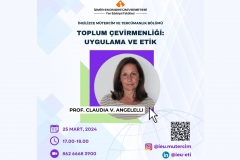
IUE Department of English Translation and Interpreting hosted Prof. Dr. Claudia V. Angelelli in the webinar titled "Community Interpreting: Practice and Ethics".
On Monday, March 25th, İzmir University of Economics Department of English Translation and Interpretation organized a webinar titled "Community Interpreting: Practice and
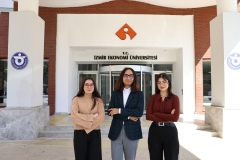
Returned to Izmir with three awards
The Young Translators Competition organized by the Ministry of Foreign Affairs Directorate for EU Affairs was marked by the success of Izmir
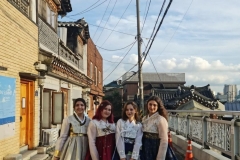
International agreements with 203 universities
Izmir University of Economics (IUE), who has signed international agreements with 203 universities with the aim of enhancing the educational opportunities offered
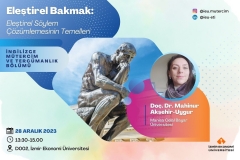
“Basics of Critical Discourse Analysis" Seminar at IUE English Translation and Interpreting Department
Izmir University of Economics, Department of English Translation and Interpreting, organized a seminar titled " Turning a Critical Eye: Basics of Critical
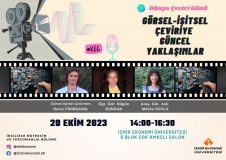
Within the framework of International Translation Day, IUE Department of English Translation and Interpreting, Faculty of Arts and Sciences, organized a panel titled "Current Approaches in Audiovisual Translation".
Within the framework of International Translation Day (September 30th), the Department of English Translation and Interpreting at Izmir University of Economics hosted
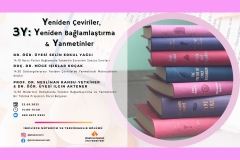
“Re-translations, Re-contextualization, and Paratexts” Panel at IUE English Translation and Interpreting Department
Izmir University of Economics, Faculty of Arts and Sciences, Department of English Translation and Interpreting organized an online panel titled "Re-translations, Re-contextualization,
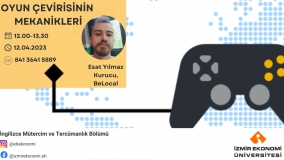
As part of the webinar series, IUE Department of English Translation and Interpreting, Faculty of Arts and Sciences, hosted Esat Yılmaz
IUE Department of English Translation and Interpreting, Faculty of Arts and Sciences, hosted Esat Yılmaz, the founder of a localization company, in

250 translators volunteered at the earthquake affected area
Izmir University of Economics, Department of English Translation and Interpretation held ‘Emergency and Disaster Interpreting’ titled seminar in order to discuss the



